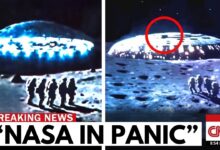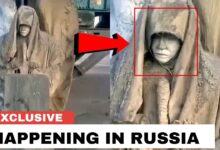Ancient viral genomes preserved in glaciers reveal the history of Earth’s climate – and how viruses adapt to climate change
Zhi-Ping Zhong, The Ohio State University; Ellen Mosley-Thompson, The Ohio State University; Lonnie Thompson, The Ohio State University; Matthew Sullivan, The Ohio State University, and Virginia Rich, The Ohio State
As humans alter the planet’s climate and ecosystems, scientists are looking to Earth’s history to help predict what may unfold from climate change. To this end, massive ice structures like glaciers serve as nature’s freezers, archiving detailed records of past climates and ecosystems – including viruses.
We are a team of microbiologists and paleoclimatologists that studies ancient microorganisms, including viruses preserved within glacier ice. Along with our colleagues Lonnie Thompson, Virginia Rich and other researchers at the Ice Core Paleoclimatology group at The Ohio State University, we investigate interactions between viruses and their environment archived in ice cores from the Guliya Glacier on the Tibetan Plateau.
By linking the genomes of ancient viral communities to specific climate conditions preserved in glacier ice, our newly published research offers insights into how these viruses have adapted to Earth’s shifting climate over the past 41,000 years.
Reading history in viral genes
We primarily used metagenomes – collections of genomes that capture the total genetic content of all microorganisms present in environmental samples – to reconstruct viral genomes from nine distinct time intervals within the Guliya ice core. These time horizons span three major cold-to-warm cycles, providing a unique opportunity to observe how viral communities have changed in response to different climatic conditions.
Through our analyses, we recovered the genomes of the equivalent of 1,705 virus species, expanding known glacier-preserved ancient viruses more than fiftyfold.
Only about one-fourth of the viral species we found shared species-level similarities with any of the viruses identified in nearly 1,000 metagenomes previously captured in global datasets. Most of these overlapping species were also from the Tibetan Plateau. This suggests that at least some viruses preserved in the Guliya Glacier originated locally in the region, but it also spoke to the relative lack of glacial viruses in available databases.
Using these new reference genomes, we attempted to “read” their stories.
One key finding was that viral communities varied significantly between cold and warm climatic periods. The most distinct community of viral species on the glacier appeared about 11,500 years ago, coinciding with the major transition from the Last Glacial Stage to the Holocene. This suggests that the unique climate conditions during cold and warm periods profoundly influenced the composition of viral communities. We hypothesize that these influences were likely due to viruses from other places being blown in by changing wind patterns and subject to selection pressures from changing temperatures on the glacier.
Digging deeper, we next determined how viruses interacted with their hosts. To do this, we used computer models to compare viral genomes with the genomes of other microbes also found in this environment. We found that viruses consistently infected Flavobacterium, a lineage of bacteria commonly found in glacier environments.

We also learned that viruses on the Guliya Glacier must “steal” genes from their hosts to manipulate their metabolisms. Encoded within the viral genomes were 50 auxiliary metabolic genes related to metabolism, including the synthesis and breakdown of vitamins, amino acids and carbohydrates. Some of these genes were abundant across all nine time intervals studied, suggesting that they help microbial hosts cope with the harsh conditions on glacier surfaces and thereby improve viral fitness.
Thus, viruses not only infect and kill cells, but they likely also alter the fitness of their hosts during infection, in turn influencing their capacity to survive in the extreme conditions of glacier environments.
Climate change over time
Our findings offer a novel perspective on how life, in the form of viruses, has responded to climatic changes over tens of thousands of years.
Understanding these ancient interactions provides a unique opportunity for future research in both virology and climate science. By studying how ancient viruses responded to past climate changes, researchers can gain valuable insights into how viruses adapt to ongoing global climate change.
We believe that glacier ice, by capturing information on microorganisms and their ecosystems over time in each layer, remains a critical resource for unraveling the history of Earth’s climate and the life it has supported – especially as glacier ice reserves rapidly diminish.
This article is republished from The Conversation, a nonprofit, independent news organization bringing you facts and trustworthy analysis to help you make sense of our complex world. It was written by: Zhi-Ping Zhong, The Ohio State University; Ellen Mosley-Thompson, The Ohio State University; Lonnie Thompson, The Ohio State University; Matthew Sullivan, Humans are 8% virus – how the ancient viral DNA in your genome plays a role in human disease and development
Researchers identified over 5,500 new viruses in the ocean, including a missing link in viral evolutionVideo: How ancient ice cores show ‘black swan’ events in history – even pandemics
Zhi-Ping Zhong receives funding support from the Byrd Postdoctoral Fellowship, Heising-Simons Foundation, National Science Foundation, Gordon and Betty Moore Foundation, and the U.S. Department of Energy’s Joint Genome Institute.
Ellen Mosley-Thompson receives funding from the Heising-Simons Foundation
Lonnie Thompson receives funding from the National Science Foundation, Chinese Academy of Sciences and Heising-Simons Foundation
Matthew Sullivan receives funding from the Gordon and Betty Moore Foundation and the U.S. Department of Energy.
Virginia Rich receives funding from the Heising-Simons Foundation.
Hundreds of Ancient Viruses Discovered Deep Inside Tibetan Glacier

Scientists have unearthed the remnants of more than 1,700 viruses from deep inside a glacier in western China. Most of these viruses are new to science.
With this discovery, the number of ancient viruses recovered from glaciers has grown fiftyfold.The viruses, gathered from a 1,000-foot ice core taken from the sprawling Guliya Glacier on the Tibetan Plateau, date back 41,000 years and span three major shifts from cold to warm.
Scientists say the viruses differed markedly between colder and warmer eras, noting that a distinct community of viruses formed during the most dramatic of these climatic shifts, at the end of the last ice age some 11,500 years ago. “This at least indicates the potential connection between viruses and climate change,” said ZhiPing Zhong of Ohio State University, lead author on the research.
Scientists posit that warming eliminated some resident viruses and that changing winds brought in new viruses from as far away as the Arctic and the Middle East. Glacial viruses likely infected other microbes, sending ripples up the food chain. Researchers say that viruses recovered from glaciers could shed light on how life evolved through past changes in climate and help clarify, for instance, whether ancient forests or wetlands were carbon sinks or sources. Their findings were published in Nature Geoscience.
While researchers have warned that some dormant viruses now being liberated from melting glaciers could potentially infect humans, the viruses unearthed from the Guliya glacier pose no risk, study authors said. They emphasized the need to gather more such viruses before glaciers melt away. Said Zhong, “Glacial ice is so precious, and we often don’t have the large amounts of material required for virus and microbe research.”
Workers breach key Klamath dams, allowing salmon to swim freely for the first time in a century
Workers breached the final dams on a key section of the Klamath River on Wednesday, clearing the way for salmon to swim freely through a major watershed near the California-Oregon border for the first time in more than a century as the largest dam removal project in U.S. history nears completion.
Crews used excavators to remove rock dams that have been diverting water upstream of two dams, Iron Gate and Copco No. 1, both of which were already almost completely removed. With each scoop, more and more river water was able to flow through the historic channel. The work has given salmon a passageway to key swaths of habitat just in time for the fall Chinook, or king salmon, spawning season.
Standing at Iron Gate Wednesday morning, Amy Bowers Cordalis, a Yurok tribal member and attorney for the tribe, cried as she watched water spill over the former dam and slowly flow back into the river.
Bowers Cordalis has fought for the removal of the Klamath dams since 2002, when she saw some of the tens of thousands of salmon die in the river from a bacterial outbreak caused by low water and warm temperatures. She said watching the river return to its natural channel felt like she was witnessing its rebirth.
“It was surreal. It was so emotional. I felt so hopeful and so satisfied that we have restored this river,” she said. “And looking at it you could almost hear the river crying, ‘I am free, I am free.’”
The demolition comes about a month before removal of four towering dams on the Klamath was set to be completed as part of a national movement to let rivers return to their natural flow and to restore ecosystems for fish and other wildlife.
As of February, more than 2,000 dams had been removed in the U.S., the majority in the last 25 years, according to the advocacy group American Rivers. Among them were dams on Washington state’s Elwha River, which flows out of Olympic National Park into the Strait of Juan de Fuca, and Condit Dam on the White Salmon River, a tributary of the Columbia.
“I am excited to move into the restoration phase of the Klamath River,” Russell ‘Buster’ Attebery, chairman of the Karuk Tribe, said in a statement. “Restoring hundreds of miles of spawning grounds and improving water quality will help support the return of our salmon, a healthy, sustainable food source for several Tribal Nations.”
Salmon are culturally and spiritually significant to the tribe, along with others in the region.
The Klamath was once known as the third-largest salmon-producing river on the West Coast. But after power company PacifiCorp built the dams to generate electricity between 1918 and 1962, the structures halted the natural flow of the river and disrupted the lifecycle of the region’s salmon, which spend most of their life in the Pacific Ocean but return up their natal rivers to spawn. The fish population then dwindled dramatically, jumpstarting decades of advocacy from tribes and environmental groups, culminating in 2022 when federal regulators approved a plan to remove the dams.
Since then, the smallest of the four dams, known as Copco No. 2, has been removed. Crews also drained the reservoirs of the other three dams and started removing those structures in March.
Along the Klamath, the dam removals won’t be a major hit to the power supply. At full capacity, they produced less than 2% of PacifiCorp’s energy — enough to power about 70,000 homes. Hydroelectric power produced by dams is considered a clean, renewable source of energy, but many larger dams in the U.S. West have become a target for environmental groups and tribes because of the harm they cause to fish and river ecosystems.
The project was expected to cost about $500 million — paid for by taxpayers and PacifiCorps ratepayers.
Oregon state Sen. Dennis Linthicum, a Republican, has argued against the dam removal project, saying the project removes important sites for water storage, flood control and fire prevention.
“We have fisheries, hatcheries that have been in place and salmon have been going to for years, and somehow that’s ‘not good enough,'” he said. “The salmon have to continue up past the dam, past J.C. Boyle, to make history,” noting a dam upstream.
It’s unclear how quickly salmon will return to their historical habitats and the river will heal. There have already been reports of salmon at the mouth of the river, starting their river journey. Michael Belchik, senior water policy analyst for the Yurok Tribe, said he is hopeful they’ll get past the Iron Gate dam soon.
“I think we’re going to have some early successes,” he said. “I’m pretty confident we’ll see some fish going above the dam. If not this year, then for sure next year.”
There are two other Klamath dams farther upstream, but they are smaller and allow salmon to pass via fish ladders — a series of pools that fish can leap through to get past a dam.
Mark Bransom, chief executive of the Klamath River Renewal Corporation, the nonprofit entity created to oversee the project, noted that it took about a decade for the Lower Elwha Klallam Tribe to start fishing again after the removal of the Elwha dams.
“I don’t know if anybody knows with any certainty what it means for the return of fish,” he said. “It’ll take some time. You can’t undo 100 years’ worth of damage and impacts to a river system overnight.”
Large patch of the Atlantic Ocean near the equator has been cooling at record speeds — and scientists can’t figure out why
When you buy through links on our articles, Future and its syndication partners may earn a commission.
 Credit: NASA / JSC
Credit: NASA / JSCFor a few months this summer, a large strip of Atlantic Ocean along the equator cooled at record speed. Though the cold patch is now warming its way back to normal, scientists are still baffled by what caused the dramatic cooling in the first place.
The anomalous cold patch, which is confined to a stretch of ocean spanning several degrees north and south of the equator, formed in early June following a monthslong streak of the warmest surface waters in more than 40 years. While that region is known to swing between cold and warm phases every few years, the rate at which it plunged from record high to low this time is “really unprecedented,” Franz Tuchen, a postdoctoral research associate at the University of Miami in Florida who is tracking the event, told Live Science.
“We are still scratching our heads as to what’s actually happening,” Michael McPhaden, a senior scientist with the National Oceanic and Atmospheric Administration (NOAA) who oversees an array of buoys in the tropics that have been gathering real-time data of the cold patch, told Live Science. “It could be some transient feature that has developed from processes that we don’t quite understand.”
Sea surface temperatures in the eastern equatorial Atlantic were the hottest in February and March, when they exceeded 86 degrees Fahrenheit (30 degrees Celsius) — the warmest months on record since 1982. When June rolled in, temperatures began plummeting mysteriously, reaching their coolest in late July at 77 F (25 C), Tuchen recently wrote in a blog post.
Forecasts showed the cooling event may be on the verge of developing into an Atlantic Niña, a regional climate pattern which tends to increase rainfall over western Africa and decrease rainfall in northeastern Brazil as well as countries hugging the Gulf of Guinea, including Ghana, Nigeria and Cameroon. The phenomenon, which isn’t as powerful as the La Niña counterpart in the Pacific, and hasn’t occurred since 2013, would have been declared if the colder-than-average temperatures persisted for three months, until the end of August.
Related: Gulf Stream’s fate to be decided by climate ‘tug-of-war’
However, the cold pocket of water has been warming in recent weeks, so “the verdict is already quite certain that it’s not gonna be classified as Atlantic Niña,” said Tuchen.
Nevertheless, figuring out just what caused the dramatic cooling would allow scientists to better understand the quirks of Earth’s climate, which can eventually benefit weather forecasting, Tuchen said. But none of the expected processes stand out so far.

“Something else going on”
Cooler surface waters are typically accompanied by stronger trade winds, which flow near the equator and are the most influential drivers of Niñas because they sweep away warm surface waters and allow deeper, cooler water to rise through a process known as equatorial upwelling. Puzzlingly, the recent cold region coincides with weaker winds southeast of the equator, which “are doing the opposite of what they should be doing if they were the reason for the cooling,” said Tuchen. “At the moment, we believe that the winds are actually responding to the cooling.”
McPhaden noted some anomalously strong winds that had developed to the west of the cold patch in May may have kickstarted the cooling at record speed, but those winds “haven’t increased as much as the temperature has dropped,” said McPhaden. “There’s something else going on.”
Scientists have modeled a handful of possible climate processes to try to explain the observed cold region, such as enormously strong heat fluxes in the atmosphere or sudden changes in ocean and wind currents. “From what we see, these are not obvious drivers of this cooling event,” said Tuchen.
While unprecedented, the recent dramatic cooling is not likely to be caused by human-driven climate change. “I can’t rule it out,” said McPhaden. “But at first blush, this is just a natural variation of the climate system over the equatorial Atlantic.”
Using data from satellites, oceanic buoys and other meteorological tools, Tuchen and McPhaden are among several climate scientists who are intently tracking the cold patch and any forthcoming effects it would have on the surrounding continents — which could take months to become apparent.
“It’s potentially going to be a consequential event,” said McPhaden. “We just have to watch and see what happens.”











